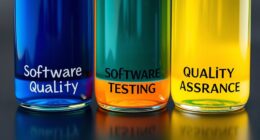To prepare for a SOC 2 audit, your QA team needs to gather exhaustive documentation of control processes, security protocols, and risk assessments. You should organize evidence of vendor management, including contracts and compliance reports, and record ongoing monitoring activities. Ensuring all control measures are up-to-date and clearly documented is essential. By focusing on thorough record-keeping and cross-team collaboration, you’ll demonstrate your compliance. Keep exploring to uncover key insights that can boost your readiness.
Key Takeaways
- Ensure controls related to security, confidentiality, processing integrity, availability, and privacy are well-documented and up-to-date.
- Collaborate with IT and compliance teams to gather evidence of control implementation and effectiveness.
- Maintain comprehensive vendor management records, including contracts, SLAs, and compliance reports.
- Conduct thorough risk assessments, identifying vulnerabilities and documenting mitigation strategies.
- Prepare clear documentation of control processes, monitoring activities, and ongoing risk management efforts.

Are you wondering what a SOC 2 audit entails and why it’s indispensable for your organization? If so, understanding the process helps you prepare effectively. At its core, a SOC 2 audit evaluates how well your organization manages data security, confidentiality, processing integrity, availability, and privacy. As part of this process, your QA teams play a critical role in guaranteeing your controls align with SOC 2 standards. One of the first things you need to focus on is vendor management. Since third-party vendors often handle sensitive data or rely on your systems, you must document and evaluate their controls thoroughly. This involves maintaining an up-to-date vendor management program, ensuring vendors meet security requirements, and regularly analyzing their risk levels. By proactively managing your vendor relationships, you reduce potential vulnerabilities and demonstrate to auditors that you have an extensive oversight process in place. Additionally, verifying the signs of spoilage in your vendors’ security practices can help prevent potential breaches. Risk evaluation is another crucial component your QA team must prioritize. During a SOC 2 audit, you’ll need to show that you’ve identified potential risks to your data and systems and implemented effective controls to mitigate them. Conducting a thorough risk evaluation helps you pinpoint areas where vulnerabilities could exist, whether from internal processes, external threats, or third-party integrations. It’s important to document this assessment meticulously, highlighting how you address each identified risk with appropriate safeguards. This not only demonstrates your commitment to security but also aligns with the auditors’ expectations for a robust control environment. Preparing for a SOC 2 audit means organizing your documentation and evidence systematically. You’ll want to ensure your vendor management records are complete, including contracts, service level agreements, and compliance reports. Similarly, your risk assessment documentation should clearly outline the process you used, the risks identified, the controls implemented, and ongoing monitoring procedures. Your QA team should collaborate closely with your IT and compliance teams to gather this information, ensuring it’s accurate and up-to-date. Consistency and thoroughness in documentation make it easier for auditors to verify your controls and reduce the time spent on clarifications. Ultimately, your goal is to present a clear picture of your control environment. By focusing on vendor management and risk evaluation, you demonstrate that your organization proactively manages third-party risks and internal vulnerabilities. Preparing well in these areas not only streamlines the audit process but also builds confidence in your organization’s ability to safeguard sensitive data. Staying organized, maintaining detailed records, and continuously reviewing your controls are key steps in guaranteeing your SOC 2 readiness and achieving a successful audit outcome.
Frequently Asked Questions
How Often Should QA Teams Update Audit Documentation?
You should update your documentation regularly to guarantee it remains accurate and reflects current practices. The audit frequency determines how often you need to review and revise this documentation; typically, it’s advisable to update it at least annually or after significant process changes. Keeping your documentation current helps you stay audit-ready, reduces discrepancies, and demonstrates ongoing compliance with relevant standards, making your audit process smoother and more efficient.
What Training Is Needed for QA Teams Regarding SOC 2 Standards?
Coincidentally, your QA team should undergo targeted SOC 2 training to stay ahead. You’ll need to focus on security awareness, ensuring everyone understands data protection and compliance. Incident response training is essential, enabling your team to handle security breaches effectively. By combining these areas, your team can proactively identify vulnerabilities, maintain audit readiness, and uphold your organization’s trustworthiness during SOC 2 evaluations.
How Can QA Automate Compliance Checks for SOC 2?
You can automate compliance checks by implementing automated testing tools that continuously monitor your systems for SOC 2 standards. These tools help you identify issues early, guarantee controls are functioning correctly, and maintain audit readiness. By integrating compliance monitoring into your regular QA processes, you reduce manual effort, improve accuracy, and stay proactive in meeting SOC 2 requirements. Automation streamlines your efforts and keeps your organization audit-ready at all times.
What Role Does QA Play During the Audit Process?
Think of QA as your shield during the audit process. You play a essential role in audit preparation by meticulously documenting controls and procedures, much like a knight preparing armor. You assist in risk assessment by identifying vulnerabilities early, ensuring compliance is maintained. Your active involvement helps demonstrate your organization’s commitment to security standards, making the audit smoother and more successful. Your vigilance is key to passing with flying colors.
How to Handle Non-Compliance Issues Identified by Auditors?
When you identify non-compliance issues, you should first engage in dispute resolution with auditors to understand their concerns clearly. Then, implement corrective actions promptly to address the problems. Document every step of this process, showing your commitment to compliance. This proactive approach not only resolves issues efficiently but also demonstrates your dedication to maintaining the integrity of your controls and ensuring ongoing adherence to standards.
Conclusion
As you prepare for your SOC 2 audit, think of it as tending to a well-kept garden—every document, control, and process is a carefully planted seed. With diligent effort, your QA team can nurture this garden into a lush landscape of trust and security. When the audit arrives, it’s like a gentle rain that helps everything bloom perfectly. Stay proactive, stay prepared, and watch your organization flourish under the bright sunlight of compliance.









